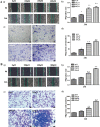Trimethylamine N-oxide promotes the proliferation and migration of hepatocellular carcinoma cell through the MAPK pathway
- PMID: 39133354
- PMCID: PMC11319703
- DOI: 10.1007/s12672-024-01178-8
Trimethylamine N-oxide promotes the proliferation and migration of hepatocellular carcinoma cell through the MAPK pathway
Abstract
Trimethylamine-n-oxide (TMAO) is a metabolite of intestinal flora following the consumption of phosphatidylcholine-rich foods. Clinical cohort studies have shown that plasma TMAO may be a risk factor for cancer development, including hepatocellular carcinoma (HCC), but fundamental research data supporting this hypothesis are lacking. In this study, HCC cells were treated with TMAO in vivo and in vitro to evaluate the effect on some indicators related to the malignancy degree of HCC, and the relevant molecular mechanisms were explored. In vitro, TMAO promoted the proliferation and migration of HCC cells and significantly upregulated the expression of proteins related to epithelial-mesenchymal transformation (EMT). In vivo, after HCC cells were inoculated subcutaneously in nude mice given water containing TMAO, the tumors grew faster and larger than those in the mice given ordinary water. The immunohistochemistry analysis showed that proliferation, migration and EMT-related proteins in the tumor tissues were significantly upregulated by TMAO. Furthermore, TMAO obviously enhanced the phosphorylation of MAPK signaling molecules in vivo and in vitro. In conclusion, TMAO promotes the proliferation, migration and EMT of HCC cells by activating the MAPK pathway.
Keywords: Hepatocellular carcinoma; MAPK; Migration; Proliferation; Trimethylamine N-oxide.
© 2024. The Author(s).
Conflict of interest statement
The authors declare no competing interests.
Figures






Similar articles
-
Gut microbiota derived metabolite trimethylamine N-oxide influences prostate cancer progression via the p38/HMOX1 pathway.Front Pharmacol. 2025 Jan 9;15:1526051. doi: 10.3389/fphar.2024.1526051. eCollection 2024. Front Pharmacol. 2025. PMID: 39850572 Free PMC article.
-
Trimethylamine N-oxide promotes atherosclerosis via CD36-dependent MAPK/JNK pathway.Biomed Pharmacother. 2018 Jan;97:941-947. doi: 10.1016/j.biopha.2017.11.016. Epub 2017 Nov 7. Biomed Pharmacother. 2018. PMID: 29136772
-
The transformation of atrial fibroblasts into myofibroblasts is promoted by trimethylamine N-oxide via the Wnt3a/β-catenin signaling pathway.J Thorac Dis. 2022 May;14(5):1526-1536. doi: 10.21037/jtd-22-475. J Thorac Dis. 2022. PMID: 35693618 Free PMC article.
-
The Role of a Gut Microbial-Derived Metabolite, Trimethylamine N-Oxide (TMAO), in Neurological Disorders.Mol Neurobiol. 2022 Nov;59(11):6684-6700. doi: 10.1007/s12035-022-02990-5. Epub 2022 Aug 20. Mol Neurobiol. 2022. PMID: 35986843 Review.
-
Trimethylamine-N-Oxide Pathway: A Potential Target for the Treatment of MAFLD.Front Mol Biosci. 2021 Oct 1;8:733507. doi: 10.3389/fmolb.2021.733507. eCollection 2021. Front Mol Biosci. 2021. PMID: 34660695 Free PMC article. Review.
Cited by
-
The metabolic dialogue between intratumoural microbes and cancer: implications for immunotherapy.EBioMedicine. 2025 May;115:105708. doi: 10.1016/j.ebiom.2025.105708. Epub 2025 Apr 22. EBioMedicine. 2025. PMID: 40267755 Free PMC article. Review.
-
The interplay between gut bacteria and targeted therapies: implications for future cancer treatments.Mol Med. 2025 Feb 13;31(1):58. doi: 10.1186/s10020-025-01108-6. Mol Med. 2025. PMID: 39948481 Free PMC article. Review.
-
Causal Relationship between Gut Microbiota and Endometrial Cancer: A Two-Sample Mendelian Randomization Study.Int J Med Sci. 2025 Jun 23;22(12):3142-3153. doi: 10.7150/ijms.112922. eCollection 2025. Int J Med Sci. 2025. PMID: 40657402 Free PMC article.
-
Bacterial metabolites: Effects on the development of breast cancer and therapeutic efficacy (Review).Oncol Lett. 2025 Mar 4;29(4):210. doi: 10.3892/ol.2025.14956. eCollection 2025 Apr. Oncol Lett. 2025. PMID: 40070782 Free PMC article. Review.
References
Grants and funding
LinkOut - more resources
Full Text Sources
